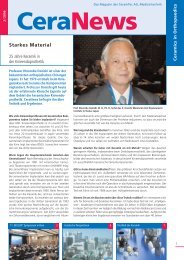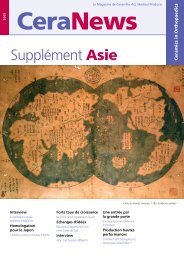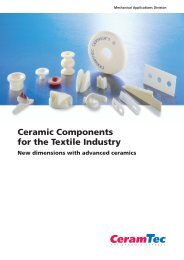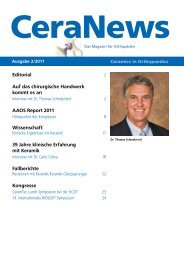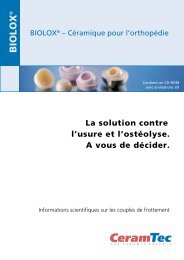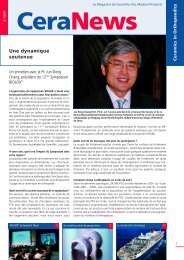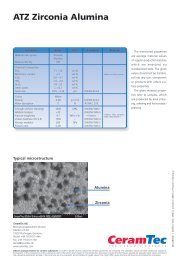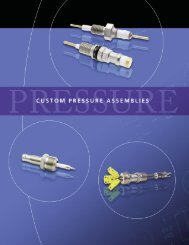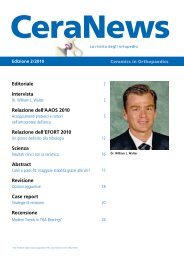Download PDF, 2.4 MB - CeramTec
Download PDF, 2.4 MB - CeramTec
Download PDF, 2.4 MB - CeramTec
You also want an ePaper? Increase the reach of your titles
YUMPU automatically turns print PDFs into web optimized ePapers that Google loves.
What is is the motive behind the latter?Klaus-Peter Günther,MD, PhDBoth physicians and industry must learn how tohandle incidents effectively. The aviation industry,for example, is somewhat ahead of us in thisrespect. They regard the incident primarily as anopportunity to improve the process. In the field ofarthroplasty, joint initiatives have been launched bymanufacturers, scientists, and surgeons. It is, afterall, essential for incidents to be recorded in a systematicmanner, which is why standardized requirementsare necessary. Physicians are often unsurehow to handle implant retrievals. While there arelegal requirements, physicians are often not sufficientlyaware of them.pulling out of advanced training because they donot get paid for it. As a result, something which issensibly regulated in theory is getting ever more difficultto implement in practice.How do you see the situation with regard to continuingeducation itself?The problem is ensuring consistently high qualityand creating appropriate general conditions. Weshould bear in mind that colleagues performingarthroplasties have to meet certain conditions. Itshould be ensured that they are constantly undergoingcontinuing education and that this is monitoredregularly. That is also the goal of the EndoCert initiative** for the establishment of certified arthroplastycenters. It would be a condition of certification thatthe clinic conducts continuing medical educationbased on structured plans and that its staff demonstrablymake regular use of the continuing medicaleducation offerings.Continuing medical education of this type is offeredin German-speaking countries by the AE, of whichyou are President. What is the goal?The primary goal of the AE is to ensure high qualitytraining and continuing medical education inthe field of arthroplasty. For this purpose, it offersa structured system of courses for physicians andoperating room personnel. In so doing, the AEdiffers significantly from other specialist societieswhich generally either focus on a single joint, suchas the hip societies, or on specific procedures, suchas the societies for arthroscopy. Our scope extendsfrom joint preserving procedures to complex revision,and includes all joints. Our other quality assuranceactivities include involvement in the Germanarthroplasty registry and EndoCert, as well as ourown initiative aimed at optimizing failure analysis.Should surgeons be obligated to undergo implantspecifictraining, the key idea being "no train, nouse"?A new product should only be used if physiciansand OR personnel have received the applicabletraining. This is a clear criterion for certificationunder the EndoCert initiative we talked aboutpreviously.What role can an arthroplasty registry play?Arthroplasty registries are of no help when analyzingindividual incidents. However, they can provideearly indications of the failure of one or more contributingfactors – e.g., a faulty implant or an applicationmistake – if problems occur frequently. Fortunately,an arthroplasty registry is now also beingestablished in Germany.What is your experience with the increasing timepressure in the German healthcare system, aboutwhich physicians are complaining? Does this haveany impacts on clinical practice?There is already a high degree of time pressureassociated with the introduction of new implants,not only from the manufacturer, but also on thepart of physicians. While the introduction of newimplants satisfies formal conditions, I would like tosee a stepwise process required for substantiallychanged or novel implants. This should start withtesting in selected arthroplasty centers, and onlythereafter should the implants be released for themarket. Outside the field of arthroplasty, we arealso facing increasing problems, with significantlyhigher strain on everyone involved to find the timefor the necessary internal and external continuingmedical education programs.** EndoCert – See also interview withMittelmeier, MD, PhD, on page 8CeraNews 1/20123



